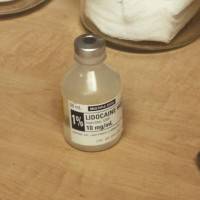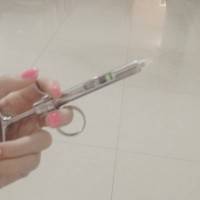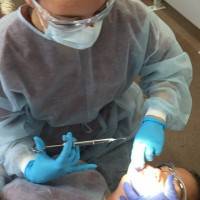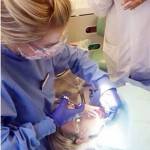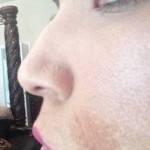Rhinoplasty With Local Sedation
Rhinoplasty under local is less comfortable
Some smaller rhinoplasty procedures can be under local anesthesia but as the procedure gets more involved and takes a little longer, you will be more comfortable with a nice gentle general anesthesia.
It is very easy to have a little drainage into the back of your nose or throat and then you will need to cough or spit and this disrupts the procedure.
The exact changes you want with your nose will have to be examined in person with your surgeon so the right modifications can be made. (Marcus L. Peterson, MD, Saint George Plastic Surgeon)
Rhinoplasty and anesthesia
I personally recommend general anesthesia for almost all of my rhinoplasty patients. It is very safe and the patient is comfortable. Local anesthesia with sedation can be done in selected patients as well. Some surgeons do local anesthesia only, but this is generally very uncomfortable for the patient.
Unfortunately I can’t see your nose well enough in the photo, so I can’t comment on fillers versus surgery. I recommend seeing a board-certified surgeon who can give oyu more specifics based upon your examination. (Nina S. Naidu, MD, FACS, New York Plastic Surgeon)
Seek an experienced rhinoplastic surgeon
Although it is important for you to have imput into the type and extent of surgery you will have, you have to remember that the Doctor has much more experience than you and you should listen to their opinion.
You would not be happy having your nose done under straight local, although it could be done that way. Come and see an experienced professional and talk to them. (William B. Rosenblatt, MD, New York Plastic Surgeon)
Rhinoplasty can be done under local anesthesia with sedation but its not safer
I initially trained by doing rhinoplasty under sedation (drowsy) and did so for over 15 years. Anesthesia drugs and monitoring has improved to the point where light general anesthesia is safer and with just as fast a recovery as sedation. The drugs used are actually the same with just a teeny bit more given so you don’t feel (or remember) a soft device called and LMA that sits on top of your voicebox. Patients really don’t want to hear us working on their noses. If you ask any anesthesiologist, LMA anesthesia is safer than sedation.
As for what procedure is best for you? It is helpful to see other views in addition to the front. A personal consultation with a rhinoplasty expert will help determine what is best for you and what needs to be done to the bridge of your nose in addition to treating the tip. (Steven J. Pearlman, MD, New York Facial Plastic Surgeon)
Rhinoplasty under Local Anesthesia can be done
Rhinoplasty was traditionally done under local anesthesia in years past on a routine basis. Now, more and more are done under general Anesthesia because the anesthesia techniques have become better and safer.
That having been said, certain aspects of rhinoplasty can certainly be performed under local anesthesia with some mild sedation such as tip refinement, nostril narrowing etc.
When bony shaping and manipulation is required, it is usually best to be under a deeper form of anesthesia. As far as your nose, I think a more close up picture would be required along with a side view to provide some opinions for refinement. (Louis M. DeJoseph, MD, Atlanta Facial Plastic Surgeon)
Rhinoplasty under local anesthesia
Rhinoplasty can be done under local anesthesia with a mild sedative. When the surgery is done this way, the swelling and bruising is minimal. Patients done this way are usually very comfortable and do not feel any pain or discomfort. You are in fact lucky that you are from NY, as there is a fantastic and highly skilled surgeon there that does all his rhinoplasties like this. His name is Norman Pastorek. I know because I trained with him. (Andres Bustillo, MD, FACS, Miami Facial Plastic Surgeon)
- Can rhinoplasty procedure be done under local anesthesia
- Can nose job be done under local anesthesia
- Can operation rhinoplasty be done under local anesthesia
- Can surgery rhinoplasty be done under local anesthesia
Nose job under local anesthesia
Local only anesthesia for rhinoplasty, especially from your photos, is a BIG MISTAKE. You are too young, you need a full nose job with fractures. Just these issues makes me think you are not ready to proceed. You MUST have realistic expectations not only concerning the results but also the procedure to accomplish the result.
I would refuse to operate upon you if I could not do deep sedation or endotracheal tube general anesthesia. (Darryl J. Blinski, MD, Miami Plastic Surgeon)
Nose job under Twilight Sedation
Yes a rhinoplasty can be performed under twilight sedation. This is my preferred method of anesthesia. Its better than general anesthesia because it provides faster recovery and I believe its safer.
Straightening the bridge typically requires breaking of the nasal bone due to the fact that the bones contribute to position of your bridge. However, your septum may also need to be straightened.
The best way to figure out what needs to be done is to have a consultation and computer imaging. This will allow you to see exactly what you will look like after the procedure. (Oleh Slupchynskyj, MD, FACS, New York Facial Plastic Surgeon)
General Anethesia with LMA for Rhinoplasty
Local anesthesia may initially sound like a good idea for nose job, but it’s not necessarily the safest, nor the easiest circumstance for you or for the surgeon.
As other posters have noted, anesthetic techniques are very safe in healthy patients. I routinely use General Anesthesia for Rhinoplasty (usually with LMA).
As far as evaluating for your nose, I would recommend a consultation with a local Rhinoplasty surgeon; your picture is not adequate to give any meaningful advice.
New York City has many qualified surgeons who match this description. (Stephen Prendiville, MD, Fort Myers Facial Plastic Surgeon)
Nose job can de done under local anesthesia with sedation.
- We commonly do nose job with local anesthesia. The key is to have a very competent, board certified anesthesiologist, an accredited operating room and recovery room, and an artistic plastic surgeon.
- A good rhinoplasty begins with a thorough exam, understanding exactly what you want, and a detailed, step by step surgical plan. So it would not be useful to suggest how your procedure should be done just based on one photograph. (George J. Beraka, MD (retired), Manhattan Plastic Surgeon)
Be more nervous about the nose job than the anesthesia.
While fear of general anesthesia is common, it is largely unfounded. The greater fear – in all seriousness -should be the rhinoplasty itself! Getting a good result from surgery requires a lot of judgment, experience, training, and ability.
Find a good rhinoplasty surgeon first, then discuss your concerns/fears about anesthesia with him/her. Modern anesthesia in properly selected and examined patients is remarkably safe and comfortable compared to years ago. The patient is most comfortable this way and the surgeon can focus more on the work at hand rather than patient movement, airway protection, etc. As for evaluating your nose, that really does require an in-office exam. A single frontal photo only shows so much. (David C. Pearson, MD, Jacksonville Facial Plastic Surgeon)
Rhinoplasty surgeons may or may not use local anesthesia.
I have used primarily general anesthesia for more than 30 years without any problem. However, if a patient wants the nose done under local anesthesia with sedation, that can be done as well.
As to what desires you have regarding the look of the nose, you should discuss this with several surgeons who are experienced and go with the one whose noses you like the best. (Toby Mayer, MD, Beverly Hills Facial Plastic Surgeon)
Anesthesia for nose job
The nose is a very sensitive region of the face. Although local only anesthesia is feasible, it is a very unpleasant experience for both the patient and the doctor. Even giving the numbing injection can be too much for most patients. At a minimum I would suggest local with sedation (twilight anesthesia). As opposed to full general anesthesia, patients tend to have less nausea afterwards and recover a little quicker (1 hour versus 2 hours for general). Other than that, there is no real benefit. If you have significant anxiety about the procedure then you should really consider full general in order to ensure that you will be comfortable.
With regards to your nose, it is hard to tell from a single picture. Overall, you have a long and thin face, which would balance well with a thinner nose throughout. Although your nose should be shortened a little bit by lifting the tip, it should not be overdone, as it would be out of balance with the rest of your face. Narrowing of the tip can be done at the same time as lifting it. Personally, I would not recommend fillers to build up the bridge. These products are temporary and will have to be re-injected, depending on the filler used, in 1-2 years. Although patients are often afraid of getting the bone work done, they realize afterwards that it was not a big deal. If you have a bump on your profile (which it does not appear that you do) bone work is often mandatory to avoid creating a space between the bones that can produce visible lines. At the time of nose job, cartilage from your septum can be used to add height to the bridge. Even without bone work, it is not uncommon to have swelling and bruising. Having bone work to narrow the bridge only makes it a little more bruised and swollen in the first 3-5 days, adding maybe 2-5 additional days of healing. In my opinion, this is well worth a result that will last a lifetime. Best of Luck! (Richard W. Westreich, MD, Manhattan Facial Plastic Surgeon)
